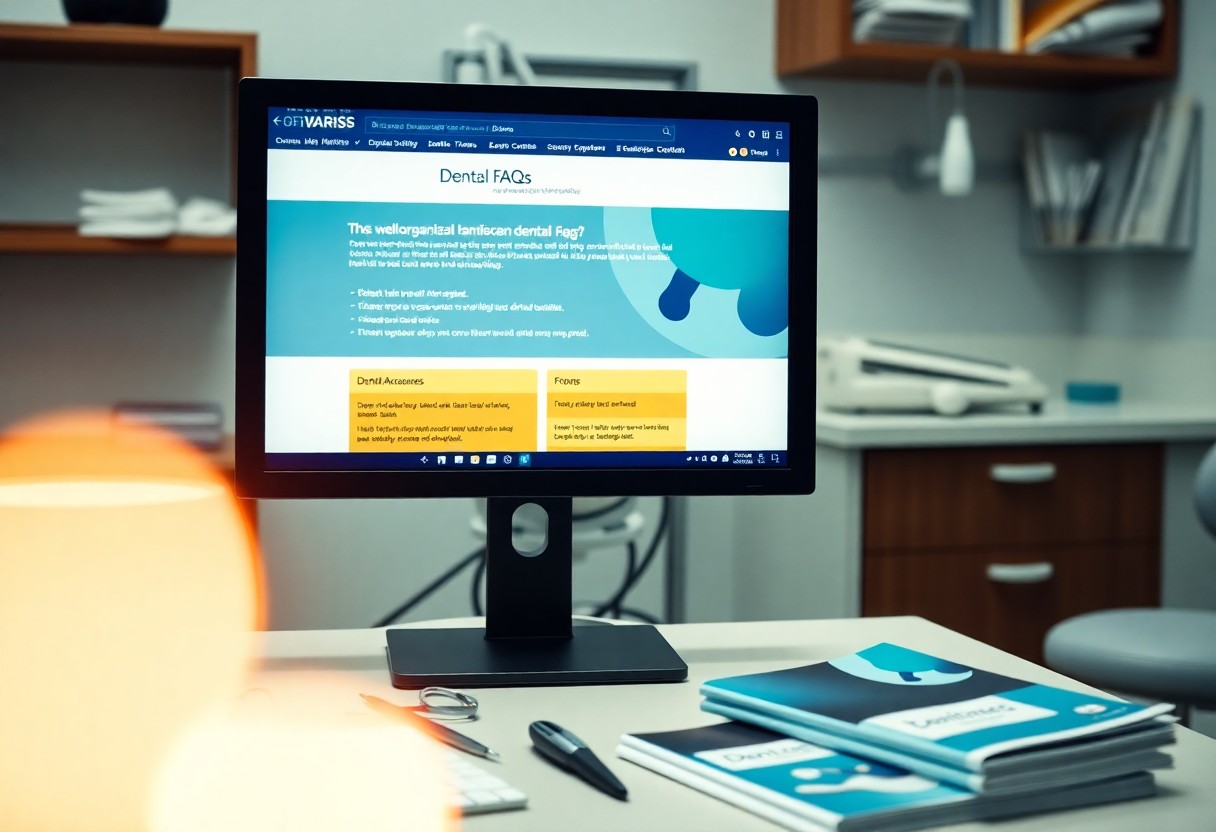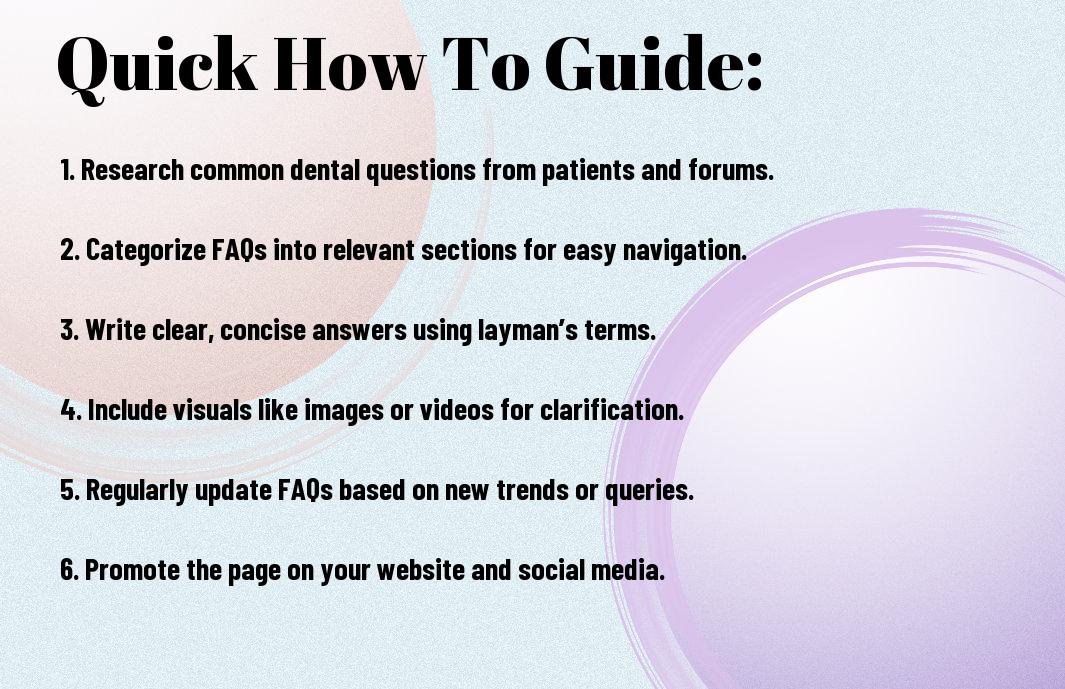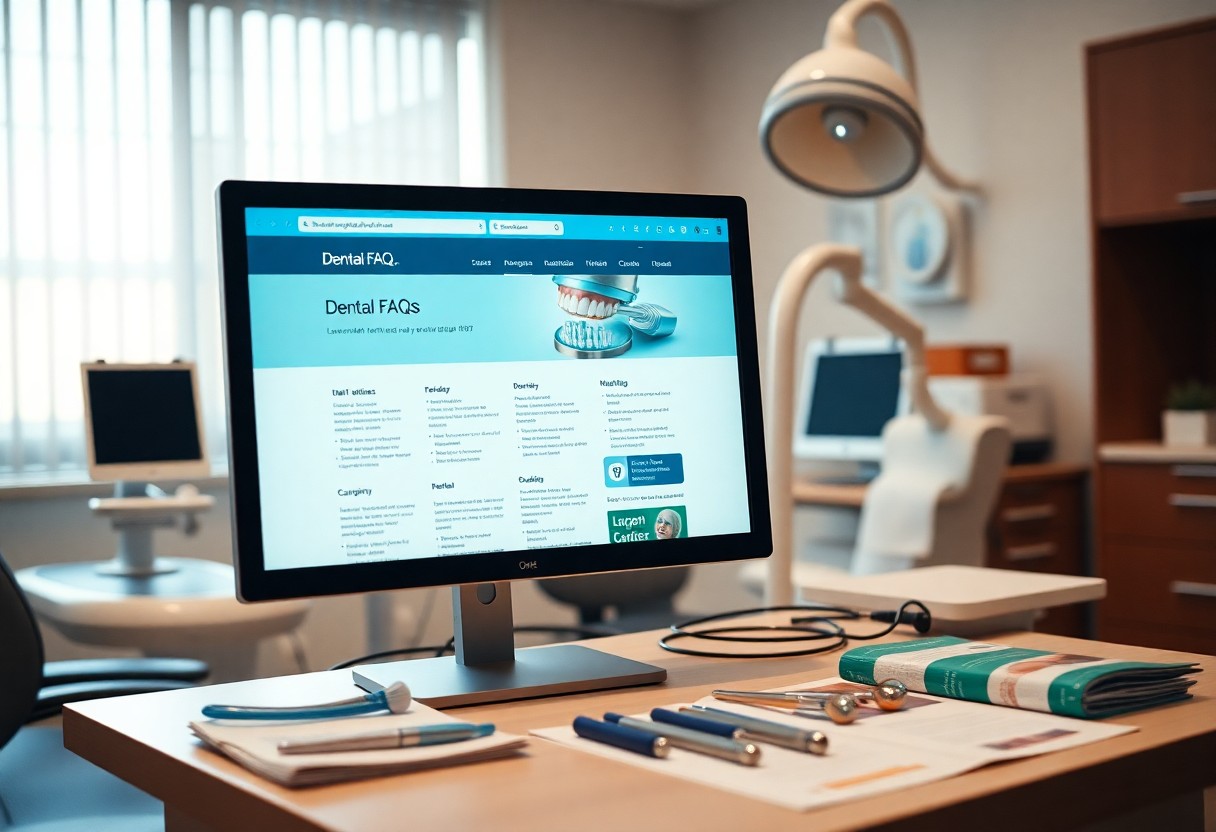How To Build A Comprehensive Dental FAQs Page To Enhance Patient Experience
Most patients have questions that, if left unanswered, can lead to misunderstandings and anxiety about dental procedures. I believe that creating a comprehensive FAQ page is an effective way to address these concerns, paving the way for a positive patient experience. In this post, I’ll guide you through the vital steps to design an informative and engaging FAQs section that not only educates your patients but also builds trust in your dental practice. Let’s examine how you can transform your FAQ page into a valuable resource for your patients.

Key Takeaways:
- Identify common questions: Gather frequently asked questions from patients to create a relevant content list.
- Organize content logically: Categorize questions into sections like services, insurance, and oral hygiene for easy navigation.
- Use clear language: Ensure answers are straightforward and easy to understand, avoiding overly technical jargon.
- Update regularly: Keep the FAQs dynamic by revisiting and revising content based on new queries or changes in practice.
- Enhance engagement: Encourage patients to submit their questions, creating an interactive experience that fosters community.
- Optimize for SEO: Use relevant keywords to improve search engine visibility and attract more visitors to the FAQs page.
- Implement a user-friendly design: Ensure the FAQs page is mobile-responsive and accessible, providing a seamless experience for users.
Understanding the Importance of a Dental FAQs Page
To create a seamless patient experience, a comprehensive dental FAQs page is a valuable tool that can significantly enhance the way your patients interact with your practice. This page serves as a dedicated resource where patients can easily find answers to common questions about procedures, insurance, and overall dental care, reducing the need for numerous phone calls or visits for basic information. By providing this resource, you’re demonstrating that you respect your patients’ time and are committed to addressing their needs proactively.
Enhancing Patient Experience
While I recognize that dental visits can often evoke anxiety in patients, having a detailed FAQs page can alleviate some of that discomfort. Patients typically have numerous questions before undergoing treatments or even during routine check-ups. By listing out answers to common inquiries, I can ensure that patients feel informed and empowered, leading to a more relaxed experience in my office.
Building Trust and Credibility
On the other hand, a well-structured FAQs page contributes to building trust and credibility for my practice. When patients can easily access accurate information, they are more likely to perceive my clinic as professional and trustworthy. This transparency not only establishes a strong relationship between me and my patients but also encourages them to share their experiences with others, fostering a positive reputation within the community.
Another significant aspect of establishing trust is the assurance of accuracy and transparency. By offering clear explanations and addressing common concerns, I aim to demystify dental procedures and highlight the ethical practices I uphold. This open communication goes a long way in reinforcing your patients’ confidence in my expertise and encourages them to return for ongoing care, thereby strengthening their long-term relationship with my practice.

How-To: Organizing Your FAQs Effectively
Some of the key elements in creating an effective FAQ page involve strategically organizing the information to ensure that your patients find the answers they need quickly. I often recommend using categories to break down the questions into digestible sections. By doing this, you not only enhance user experience but also highlight the specific concerns that different patients may have. You could categorize the FAQs based on topics such as general dental care, appointment scheduling, billing queries, and preventive care among others. This approach allows patients to navigate the page more efficiently, fostering a more positive and informative encounter with your practice. For additional insights on enhancing patient experiences, I suggest checking out this article on How to Improve the Patient Experience in a Dental Office.
Categorizing Common Questions
While working on your FAQ page, categorizing common questions is a great first step. You’ll find that patients often have similar inquiries, so grouping these questions can save time and reduce frustration. For instance, if several patients ask about the procedures for teeth whitening, you can create a dedicated section just for cosmetic procedures. This not only streamlines the information but also encourages visitors to peruse other related questions that they might not have considered initially.
Prioritizing Relevance and Frequency
Prioritizing relevance and frequency should be at the forefront of your FAQ organization strategy. I’ve learned that the most effective FAQs address the questions that are asked most frequently by patients. By featuring these questions prominently, you’re more likely to meet the immediate needs of your visitors. Not only will this help in providing quick solutions, but it also demonstrates that you value their time and concerns.
This ensures that your FAQ page is serving its purpose effectively. For instance, if you notice that new patients often inquire about your initial consultation process, consider placing that question at the top of your list. By prioritizing such inquiries, you not only give patients quick access to imperative information but also build trust and transparency in your practice. Keep in mind, a well-organized list of FAQs can significantly impact patient satisfaction, illustrating that you care about addressing their concerns proactively.
Tips for Crafting Clear and Concise Answers
Now, when I set out to create a Dental FAQs page, I find that clarity and brevity are my best friends. It’s vital to craft answers that are straightforward and engaging. Here’s what I usually consider to ensure that my messages come through clearly:
- Focus on the main question to avoid digressions.
- Use bullet points or lists when appropriate for easy readability.
- Break down complex information into simpler segments.
- Keep sentences short and direct.
- Incorporate visual aids when possible to supplement the text.
Assume that your readers are often looking for immediate answers. When responding, aim for sentences that provide the information they need without convoluted explanations. This method not only addresses their queries effectively but also enhances their overall experience with your practice.
Using Simple Language
Answers should be easy to understand, so I recommend employing simple language throughout your responses. This approach allows you to connect with a diverse audience, ensuring patients of all backgrounds can comprehend the information easily. Avoid unnecessary complexity; instead, aim for a friendly tone that feels approachable. You’ll want your patients to walk away feeling informed rather than confused.
Utilizing straightforward words and phrases not only simplifies your message but also builds trust. When I convey facts in an uncomplicated manner, patients are more likely to engage with the material. Assume that when the language is accessible, they are empowered to ask more questions if they have any, fostering a sense of community between the provider and patient.
Avoiding Jargon and Technical Terms
Jargon can be a significant barrier to effective communication. I always strive to minimize or completely avoid technical terms that may alienate or confuse patients. This means taking a step back and analyzing my responses from a patient’s viewpoint—would I understand this if I didn’t have a medical background? If the answer is no, then it’s time to rephrase.
When I do encounter a *necessary* technical term, such as “periodontal disease,” I try to provide a brief explanation or use simpler synonyms. By focusing on clear language, not only do you ensure understanding, but you also provide a positive patient experience that encourages continued dialogue and trust. *In summary*, while technical language can provide precision, it often complicates communication; my goal is to inform, not isolate.

Factors to Consider When Designing Your FAQs Page
For any dental practice, an effective FAQs page can serve as a valuable resource for enhancing patient understanding and engagement. When designing your FAQs page, I suggest considering the following factors to ensure it meets the needs of your patients:
- Clarity of Questions and Answers
- Search Functionality
- Visual Appeal
- Category Organization
Any time you invest in developing a comprehensive FAQs page will undoubtedly improve patient experience. You can also explore How to improve the dental patient experience: 6 tips for additional insights.
User-Friendly Navigation
Clearly, your FAQs page should be designed for easy navigation to maximize its usefulness. I find that organizing questions into well-defined categories or topics allows patients to locate the information they need without feeling overwhelmed. A search bar is also a worthwhile addition, enabling users to type in keywords related to their inquiries directly.
Additionally, using a simple layout with clear headers, concise questions, and straightforward answers not only enhances readability but also reduces frustration. I encourage you to employ bullet points or numbered lists where applicable, making the content scannable and digestible for your visitors.
Mobile Responsiveness
Mobile optimizations are necessary for reaching patients who frequently access the web via their smartphones. Mobile issues can deter potential patients from finding necessary information, impacting their overall satisfaction and level of trust in your practice. I advocate for a design that provides a seamless experience on various screen sizes, ensuring your FAQs page remains accessible and functional regardless of how it’s viewed.
Consider that over 50% of all web traffic now comes from mobile devices. It’s important to implement a responsive design that adjusts seamlessly to different screen resolutions. Images and text should resize properly, maintaining clear visibility and engaging presentation. A well-optimized mobile FAQs page will not only save time for your patients but may also enhance their overall perception of your practice.
How-To: Updating Your FAQs Regularly
All dental practices should prioritize the practice of regularly updating their FAQs to ensure that the information shared is both relevant and accurate. Your patients rely on FAQs to answer questions that may influence their decision to visit your practice, so keeping this section up-to-date can significantly enhance their overall experience. I find that routine reviews of my FAQs can reveal areas that need improvement, such as outdated services or changes in procedures that may not be reflected in the existing content. This proactive approach not only maintains patient trust but also positions your practice as a reliable source of information.
Monitoring Patient Feedback
FAQs are often shaped by the questions I receive from patients. Consequently, monitoring patient feedback is important for identifying gaps in the existing content. By keeping an open line of communication through surveys, suggestion boxes, or direct inquiries, you can gather valuable insights about what information patients may be seeking. I find that paying attention to the most asked questions can inform necessary updates, ensuring that your FAQs become a dynamic resource that evolves alongside your practice.
Adapting to New Services and Trends
Any dental practice must stay on top of emerging services and trends within the industry. As new treatments and technologies arise, it’s important to revise your FAQs to reflect these advancements. For instance, if I introduce a new dental service like teledentistry, I ensure that clear guidelines are available for patients who may be unfamiliar with the process. It not only educates them but also encourages them to explore available options confidently.
Monitoring shifts in patient interest and adapting your FAQs accordingly can positively impact patient satisfaction. I use tools like analytics and patient interactions to assess what topics are gaining traction, such as preventive care or cosmetic dentistry trends. By integrating this information into my FAQs, my goal is to create an up-to-date, informative resource that helps patients feel more engaged and supported in their dental health journey.
Encouraging Patient Interaction
Despite the wealth of information provided on your dental FAQs page, fostering a two-way communication channel can significantly enhance patient experience. Engaging with your patients allows me to better understand their needs and concerns. By encouraging interaction, I create a welcoming environment where patients feel valued and heard, which ultimately contributes to building trust and loyalty.
Utilizing Surveys for Additional Questions
Even after you’ve compiled a comprehensive FAQ section, there might still be questions that haven’t been addressed. Conducting patient surveys can be an effective way to identify these gaps in information. By regularly reaching out to your patients and asking what questions they still have, I can ensure that my FAQ page remains a dynamic and responsive resource that accurately reflects patient concerns.
Providing Contact Information for Further Inquiries
Utilizing clear and accessible contact information fosters open communication between you and your patients. By including a dedicated phone number, email address, or even a contact form, I make it easy for patients to reach out with any questions that may not be covered. This accessibility not only enhances their experience but also reflects my commitment to providing excellent service.
Another important aspect of providing contact information is ensuring that patients know when and how to reach out. Whether through phone, email, or online messaging, make sure to specify hours of availability for your practice. I find that including a brief response time expectation can also help to alleviate any anxiety patients may feel when seeking clarification. By prioritizing these communication avenues, you reinforce the positive relationship you’re building with your patients and encourage them to interact more freely.
Final Words
Ultimately, as you launch on creating a comprehensive dental FAQs page, you’ll find that it serves as an invaluable resource for both your practice and your patients. By addressing common questions and concerns, you can foster a sense of trust and transparency, which is vital in building lasting relationships with your patients. I encourage you to consider the specific needs of your audience, regularly update your FAQs based on patient feedback, and ensure that the information is easily accessible and user-friendly. This will not only enhance your patients’ experience but also position your practice as a reliable source of dental care information.
Furthermore, I urge you to view your FAQs page as a dynamic tool rather than a static element of your website. Your commitment to continuously refine and expand the content based on evolving patient inquiries will make your practice more adaptable and responsive to their needs. By doing so, you will not only improve patient communication but also establish your authority in the field of dentistry. As you implement these strategies, you’ll ultimately create a positive impact on patient satisfaction and retention, setting your practice up for long-term success.





